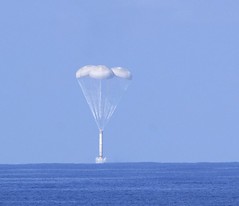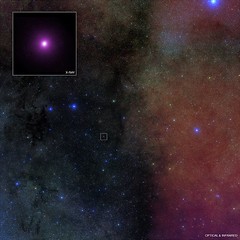
SYSKEPSI EPITROPIS SYNEDRIOY ND (2)
Originally uploaded by Νέα Δημοκρατία
For me, it is far better to grasp the Universe as it really is than to persist in delusion, however satisfying and reassuring. Carl Sagan

Hi everyone -- I came across this image as part of something else I was working on today, and I thought it was too good not to share. An image of the backlit International Space Station, taken in March of 2009. Enjoy!

This is a really nice graphic that was developed for the LCROSS/LRO missions.
Image credit: NASA
Follow the "New Moon Missions" blog from NASA:
blogs.nasa.gov/cm/blog/moon_missions/
Compose your blog entry

Source: photojournal.jpl.nasa.gov/catalog/pia04304
Image of Mars compiled from images captured by the Viking Orbiter 1. The center of the scene shows the entire Valles Marineris canyon system, over 1,860 miles (3,000 km) long and up to 5 miles (8 km) deep, extending from Noctis Labyrinthus, the arcuate system of graben to the west, to the chaotic terrain to the east. Credit: NASA/USGS
Source: www.esa.int/esaMI/Mars_Express/SEM21TVJD1E_1.html
The image of Phobos was taken by the High Resolution Stereo Camera (HRSC) on board ESA’s Mars Express spacecraft, is one of the highest-resolution pictures so far of the Martian moon Phobos.
The image shows the Mars-facing side of the moon, taken from a distance of less than 200 kilometres with a resolution of about seven metres per pixel during orbit 756, on 22 August 2004. Credits: ESA/DLR/FU Berlin
Uploaded by TopTechWriter.US on 12 Apr 08, 5.16AM EEST.

Space Shuttle Atlantis Rides Piggyback on Way Home (NASA, Space Shuttle, 6/1/09)
Hi everyone -- this is a topic I don't normally cover on my postings: the space shuttle. But the Marshall Center is helping out with the Shuttle Ferry Flight blog, and I thought we'd share these great images from it. You can read the blog and ride along with Atlantis here:
blogs.nasa.gov/cm/blog/shuttleferry
Caption: Space shuttle Atlantis’ ferry flight is under way! The modified Boeing 747 Shuttle Carrier Aircraft carrying Atlantis took off from Edwards Air Force Base in California at 11:06 a.m. EDT. The Shuttle Carrier Aircraft is heading to Biggs Army Air Field in El Paso, Texas, and is expected to arrive about 1:10 p.m. EDT. The shuttle and the ferry flight team will stay at Biggs overnight and then continue on tomorrow morning to NASA's Kennedy Space Center.
Image credit: NASA

Read more about the Ares I-X launch:
www.nasa.gov/ares
p.s. You can see all of the Ares photos in the Ares Group in Flickr at: www.flickr.com/groups/ares/ We'd love to have you as a member!

Artist concept of the Ares I-X rocket.
Read more about the Ares I-X launch:
www.nasa.gov/ares
p.s. You can see all of the Ares photos in the Ares Group in Flickr at: www.flickr.com/groups/ares/ We'd love to have you as a member!

Atlantis Comes Home [1680x1050]
Space Shuttle Atlantis and the STS-117 crew returned home safely today, completing their 14-day mission to the International Space Station. The mission launched on June 8, 2007, and ended today at 3:49 p.m EDT, when Atlantis touched down at Edwards Air Force Base.
Source: NASA
www.nasa.gov/multimedia/imagegallery/image_feature_853.html

Space Shuttle Solid Rocket Boosters (NASA, 4/29/09)
The space shuttle twin solid rocket boosters separate from the orbiter and external tank at an altitude of approximately 24 miles. They descend on parachutes and land in the Atlantic Ocean off the Florida coast, where they are recovered by ships, returned to land, and refurbished for reuse. These images show a typical descent phase and parachute deployment events of the boosters after separation from the tank and orbiter during a shuttle launch.
Image credit: NASA

Coronet Cluster is Star-Making Hotspot (Chandra)
The Corona Australis region -- containing, at its heart, the Coronet Cluster -- is one of the nearest and most active regions of ongoing star formation. At only about 420 light years away, the Coronet is over three times closer than the Orion Nebula is to Earth. The Coronet contains a loose cluster of a few dozen young stars with a wide range of masses and at various stages of evolution.
Image credit: X-ray: NASA/CXC/CfA/J. Forbrich; Infrared: NASA/Spitzer/CfA/L. Allen

New results from NASA's Chandra X-ray Observatory have made a major advance in explaining how a special class of black holes may shut off the high-speed jets they produce. The results suggest that these black holes have a mechanism for regulating the rate at which they grow. The study looks at a famous micro-quasar in the Milky Way galaxy and regions close to its event horizon -- the point of no return.
Black holes come in many sizes: the supermassive ones, including those in quasars, which weigh in at millions to billions of times the mass of the Sun, and the much smaller stellar-mass black holes which have measured masses in the range of about 7 to 25 times the Sun's mass. Some stellar-mass black holes launch powerful jets of particles and radiation, like seen in quasars, and are called "micro-quasars".
The new study looks at a famous micro-quasar in our own Galaxy, and regions close to its event horizon, or point of no return. This system, GRS 1915+105 (GRS 1915 for short), contains a black hole about 14 times the mass of the Sun that is feeding off material from a nearby companion star. As the material swirls toward the black hole, an accretion disk forms.
This system shows remarkably unpredictable and complicated variability ranging from timescales of seconds to months, including 14 different patterns of variation. These variations are caused by a poorly understood connection between the disk and the radio jet seen in GRS 1915.
Chandra, with its spectrograph, has observed GRS 1915 eleven times since its launch in 1999. These studies reveal that the jet in GRS 1915 may be periodically choked off when a hot wind, seen in X-rays, is driven off the accretion disk around the black hole. The wind is believed to shut down the jet by depriving it of matter that would have otherwise fueled it. Conversely, once the wind dies down, the jet can re-emerge.
Image credit: X-ray: NASA/CXC/Harvard/J. Neilsen et al. Optical: Palomar DSS2
Read more/see larger images:
www.nasa.gov/mission_pages/chandra/multimedia/photo09-020...
Learn more about Chandra:
www.nasa.gov/chandra
p.s. You can see all of our Chandra photos in the Chandra Group in Flickr at: www.flickr.com/groups/chandranasa/ We'd love to have you as a member!



enjoy tmt
treble tribbles
i've been chuckling about this for awhile. i need to redo this, but it's fine fun for now.
...for those who are wondering were i have been, i haven't felt like doing much of anything lately.

dedicated to TMT
tribble nibble
...a bit more humor ; )
I found this fascinating quote today:
regarding posters from star trek 11
addthis_url = 'http%3A%2F%2Fscifidrive.com%2F2008%2F11%2F22%2Fnew-star-trek-11-trailers-posters%2F'; addthis_title = 'New+Star+Trek+11+Trailers+%26%23038%3B+Posters'; addthis_pub = '';scifidrive, SciFiDrive, Nov 2008
You should read the whole article.
I found this fascinating quote today:
Basically, it’s a mini DSLR look-alike, nearly pocketable, with a 15x zoom lens, imaging to a CCD capable of acquiring 10.0 million pixels. In stills shooting, the camera uses an optical stabiliser; when shooting movies, a less desirable digital stabiliser is used.Fujifilm Finepix S2000HD Review, Feb 2009
You should read the whole article.
I found this fascinating quote today:
Την Τετάρτη 18/2 πρόκειται να εκδικαστεί (;) η υπόθεση του blogme, του Αντώνη Τσιπρόπουλου δηλαδή, που το καλοκαίρι του 2006 είχε συλληφθεί κατόπιν μήνυσης κατ’ αγνώστων του Δημοσθένη Λιακόπουλου (του γνωστού τηλεβιβλιοπώλη), επειδή ο aggregator του αναδημοσίευε τα ποστ από το blog του FunEl (κατά του οποίου βασικά στρεφόταν η μήνυση Λιακόπουλου), όχι για κανένα άλλο λόγο αλλά επειδή αυτό κάνουν οι aggregators: αναδημοσιεύουν περιεχόμενο.metablogging.gr » Blog Archive » Δίκη blogme: Επεισόδιο 3ο, Jun 2007
You should read the whole article.











"Ah, Kirk, my old friend. Do you know the Klingon proverb that tells us 'revenge is a dish that is best served cold'? It is cold in space." -- Kahn
